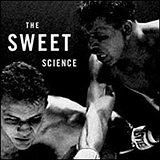Book Review: The Sweet Science
A.J. Liebling’s classic work of journalism about the fight game is back in print.
The Sweet Science, by A.J. Liebling. (North Point Press).
By Bill Marx
In 2002, “Sports Illustrated” named “The Sweet Science” the “best American sports book of all time.” Since its author, A.J. Liebling would have turned 100 on October 18, 2004, and his 1956 book is back in print from North Point Press, it is a good time to celebrate the writer and his words.
Writer Ishmael Reed insists that “writin’ is fightin’.” Well, by Reed’s definition that would make A. J. Liebling not only a great fighter, but the undisputed champion of writing about fighting. The greatness of his stories on boxing isn’t simply rooted in his encyclopedic knowledge and unstinting curiosity. Boxing is a brutal sport, but Leibling is all finesse.
For him, the page was an inky fight ring: in the space of a paragraph Leibling turns from heavyweight to flyweight and back, peppering readers with a variety of socko sentences: sardonic feints, instructional asides, and horse laugh hammer blows. For example, check out a sampling of his nifty moves in piece on Joe Louis’s 1951 fight against Joe Savold:
“A couple of times it looked like as if Louis was trying for a knockout, but when Savold didn’t come apart, Louis returned to jabbing. A man somewhere behind me kept saying to a companion, ‘I read Savold was a tricky fighter. He’s got to do something!’ But Savold didn’t until late in the fifth round, by which time his head must have felt like a sick music box.”
Images such as these are why “The Sweet Science” is a classic work of journalism that just happens to be about sports. You don’t have to care a whit about boxing to want to sit ringside with Liebling, who was as enamored with the life around the ring as with the boxing matches themselves.

Most of “The Sweet Science” deals with boxing when it was going into decline in the early 1950’s. Once television began to dictate its economics, the once glamorous sport sank into seedy obscurity. For Liebling, boxing cranked out sluggers like Rocky Marciano rather than boxers like Joe Louis. Liebling’s brilliance is that he filters this decadence through a tongue-in-cheek, yet reverent, memory of the fabled past. Unfortunately, Liebling died in 1963, before Cassius Clay became a champion. Still, he wrote about the young fighter’s talents as a boxer and a wordsmith.
The pages of “The Sweet Science” are crowded with amusing, linguistically challenged characters, from fast talking trainers and managers to deranged fans. A writer for three decades at “The New Yorker,” Liebling excelled at sympathetic but savvy yarns about real life petty con men, the city’s underground of hucksters and hawkers. Perhaps that explains why Liebling’s writing escapes the sins of sports writing today: cynicism, sentimentality, and hyperbole. Liebling’s “The Sweet Science” is one of the finest sports books ever written because it combines the innocent passion of a fan with the hard-boiled scrutiny of a detective.
Bill Marx is the editor-in-chief of The Arts Fuse. For over three decades, he has written about arts and culture for print, broadcast, and online. He has regularly reviewed theater for National Public Radio Station WBUR and The Boston Globe. He created and edited WBUR Online Arts, a cultural webzine that in 2004 won an Online Journalism Award for Specialty Journalism. In 2007 he created The Arts Fuse, an online magazine dedicated to covering arts and culture in Boston and throughout New England.
